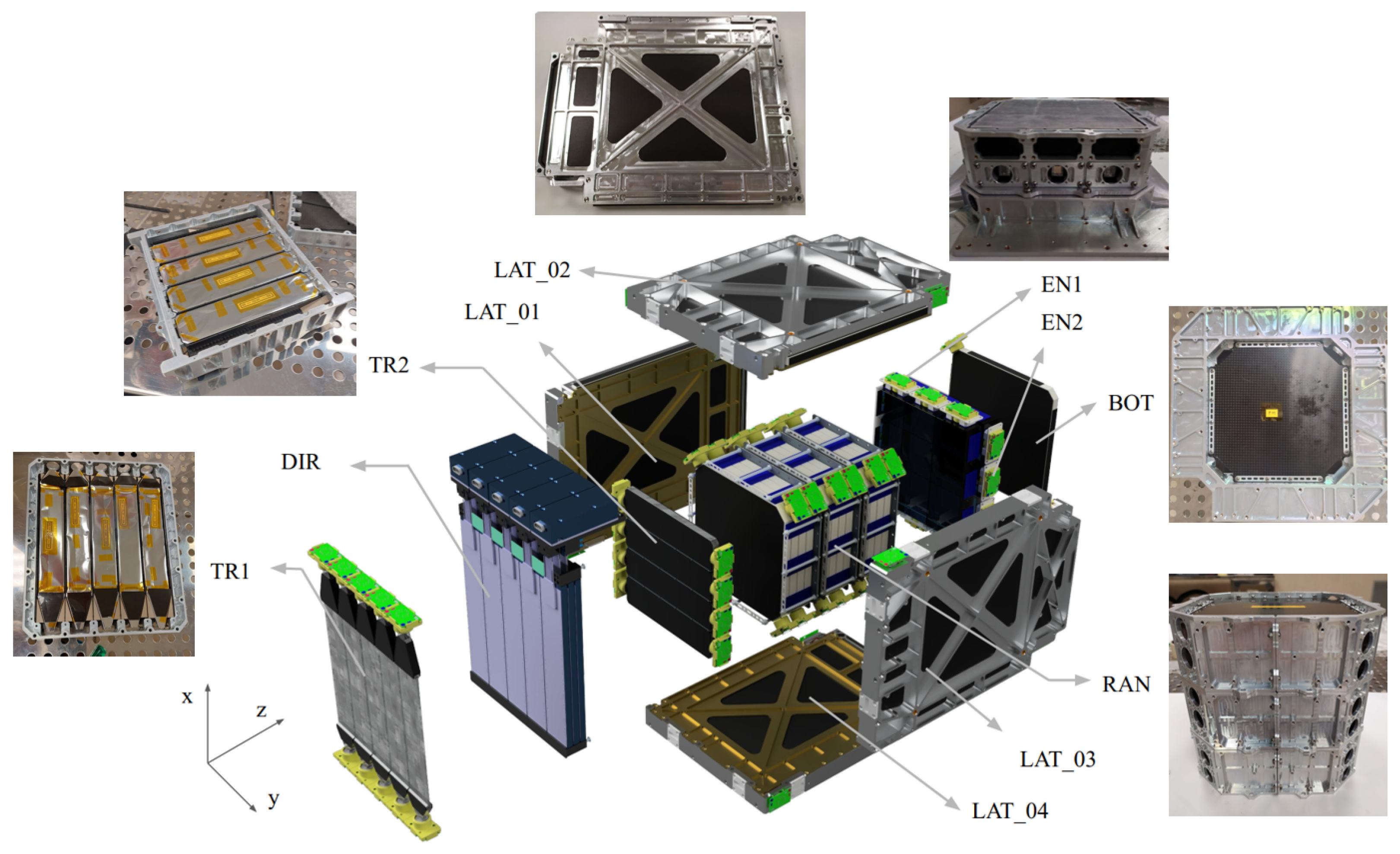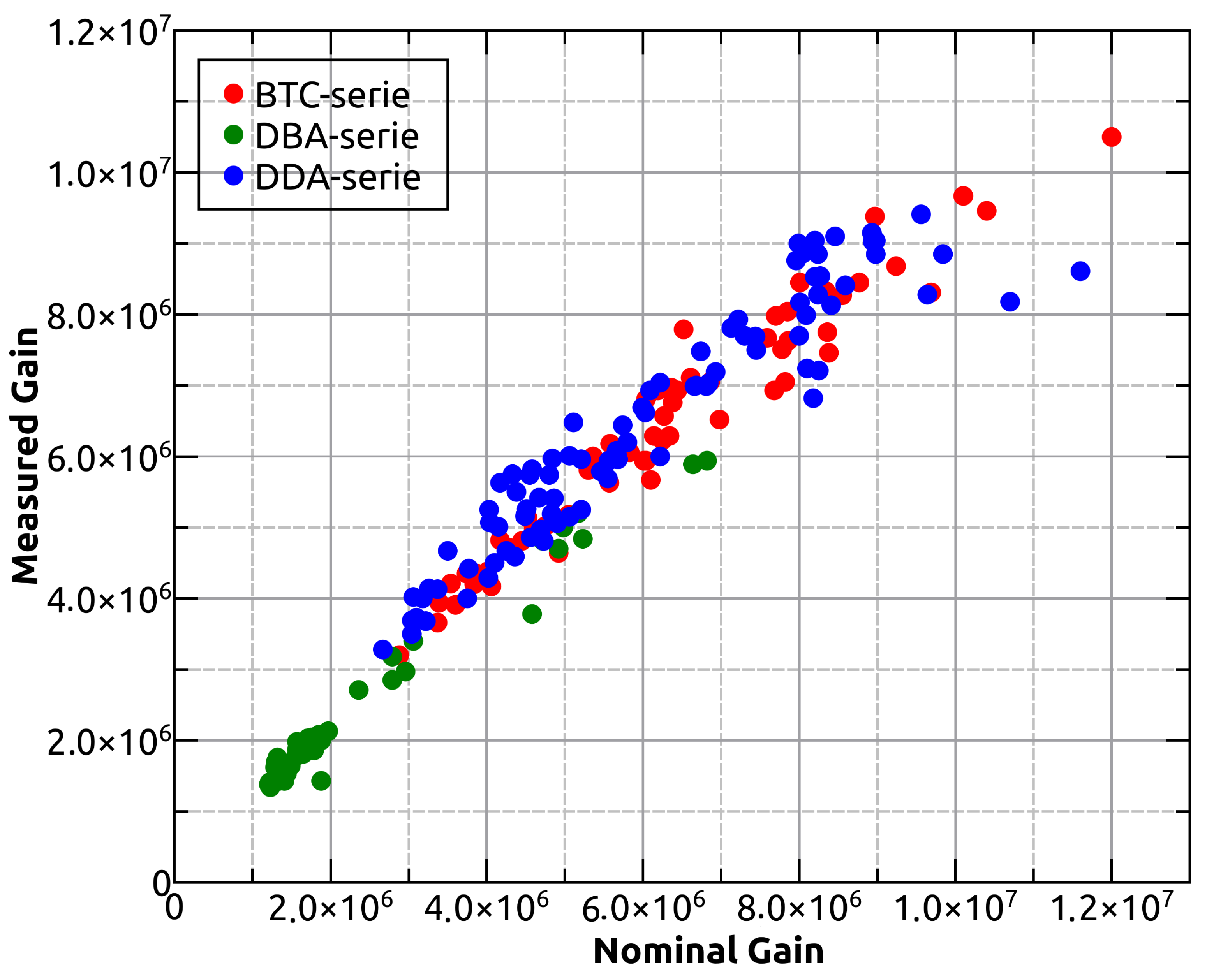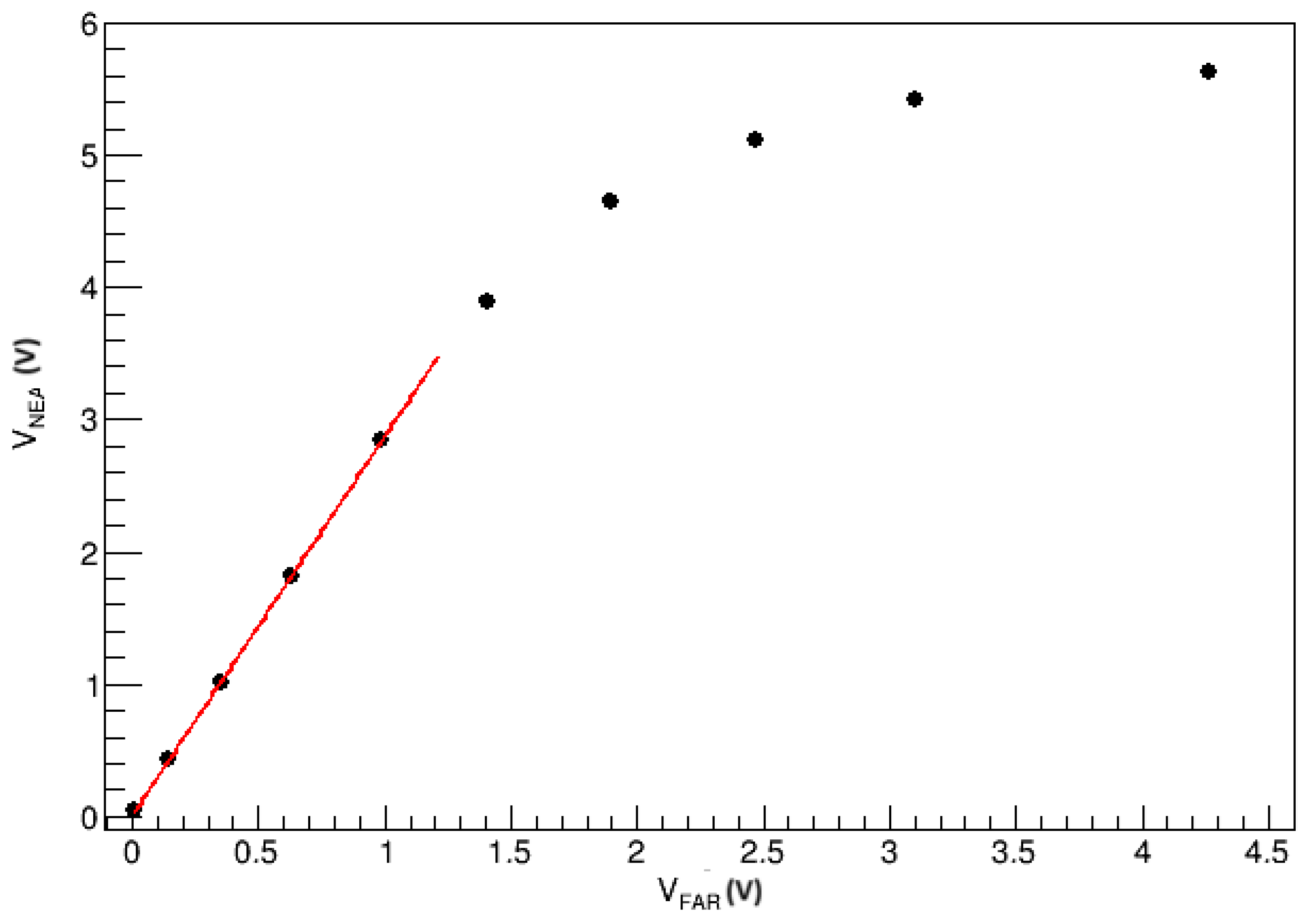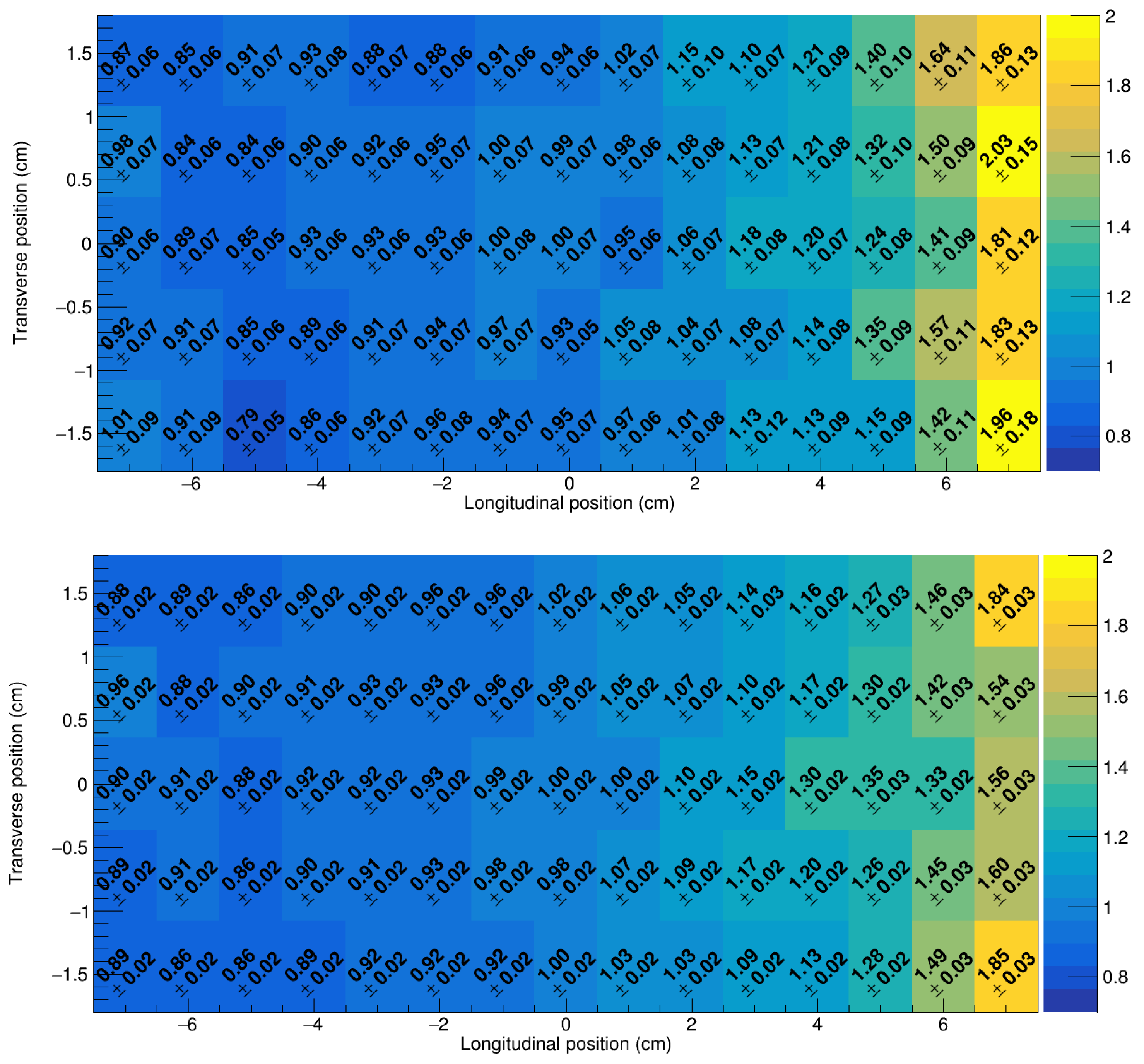The Scintillation Counters of the High-Energy Particle Detector of the China Seismo-Electromagnetic (CSES-02) Satellite
Abstract
:1. Introduction
2. The High-Energy Particle Detector
- Trigger Detector (TR1): The plane is made up of five 2 mm thick, plastic scintillation counters of . Both ends of each scintillator are coupled to flat, 6 mm thick, light guides. The light guides, in a trapezoidal shape, have different lengths on the two sides—25 mm at one side and 46 mm at the other. Each guide ends in a window where it is coupled to the PMT active area. TR1 thickness is kept to a minimum to allow for the triggering of MeV particles that are of particular interest for the HEPD-02 physics.
- Direction Detector (DIR): It has dimensions of and is made of five standalone tracking modules, each composed of three layers of MAPS [6].
- Trigger Detector (TR2): The second trigger plane is composed of four 8 mm thick plastic scintillators, oriented perpendicularly to TR1 counters, with dimensions of .
- Range Detector (RAN): The calorimeter is divided into two sections, whereby the upper one is made of a tower of twelve 10 mm thick plastic scintillators with dimensions of , named RAN1 to RAN12, enclosed into three separated mechanical units.
- Energy Detector (EN): The bottom part of the calorimeter is composed of two orthogonal layers, EN1 and EN2, of three 25 mm thick LYSO crystal bars measuring .
- Containment Detector (CD): Five 8 mm thick plastic scintillator panels enclose the detection volume and, in anti-coincidence with the trigger, reject particles not completely absorbed into the calorimeter. The bottom panel (BOT) has dimensions measuring , while the lateral ones (LAT) have an envelope size of .
3. Counter Prototype Validation
4. LYSO Crystal Characterization
4.1. Calibration of the Energy Response
4.2. Estimation of the Spectrum Due to the Intrinsic Activity of Lutetium
5. PMT Calibration
6. Simulation
7. Conclusions
Supplementary Materials
Author Contributions
Funding
Data Availability Statement
Conflicts of Interest
Abbreviations
| BOT | Bottom containment panel |
| CSES | China Seismo-Electromagnetic Satellite |
| DIR | Direction Detector |
| EN | Energy Detector |
| FM | Flight Model |
| GEANT4 | Geometry and Tracking |
| GRBs | Gamma-Ray Bursts |
| HEPD | High-Energy Particle Detector |
| HV | High Voltage |
| LAT | Lateral Containment Panel |
| LED | Light-Emitting Diode |
| LYSO | Cerium-doped Lutetium–Yttrium Oxyorthosilicate (:Ce) |
| MAPSs | Monolithic Active Pixel Sensors |
| MPV | Most Probable Value |
| NESSiE | Neutrino Experiment with Spectrometers in Europe |
| p.e. | photo-electron |
| PMTs | Photomultiplier Tubes |
| PMMA | Polymethyl Methacrylate |
| QM | Qualification Model |
| RAN | Range Detector |
| TR1 | Trigger Detector 1st plane |
| TR2 | Trigger Detector 2nd plane |
References
- Shen, X.; Zhang, X.; Yuan, S.; Wang, L.; Cao, J.; Huang, J.; Zhu, X.; Picozza, P.; Dai, J. The state-of-the-art of the China Seismo-Electromagnetic Satellite mission. Sci. China Tech. Sci. 2018, 61, 634. [Google Scholar] [CrossRef]
- Picozza, P.; Battiston, R.; Ambrosi, G.; Bartocci, S.; Basara, L.; Burger, W.J.; Campana, D.; Carfora, L.; Casolino, M.; Castellini, G.; et al. Scientific Goals and In-Orbit Performance of the High-Energy Particle Detector on Board the CSES. Astrophys. J. Supp. Ser. 2019, 243, 16. [Google Scholar] [CrossRef]
- Martucci, M.; Sparvoli, R.; Bartocci, S.; Battiston, R.; Burger, W.J.; Campana, D.; Carfora, L.; Castellini, G.; Conti, L.; Contin, A.; et al. Trapped Proton Fluxes Estimation Inside the South Atlantic Anomaly Using the NASA AE9/AP9/SPM Radiation Models along the China Seismo-Electromagnetic Satellite Orbit. Appl. Sci. 2021, 11, 3465. [Google Scholar] [CrossRef]
- Martucci, M.; Laurenza, M.; Benella, S.; Berrilli, F.; Del Moro, D.; Giovannelli, L.; Parmentier, A.; Piersanti, M.; Albrecht, G.; Bartocci, S.; et al. The First Ground-Level Enhancement of Solar Cycle 25 as Seen by the High-Energy Particle Detector (HEPD-01) on Board the CSES-01 Satellite. Space Weather 2023, 21, e2022SW003191. [Google Scholar] [CrossRef]
- Palma, F.; Martucci, M.; Neubüser, C.; Sotgiu, A.; Follega, F.M.; Ubertini, P.; Bazzano, A.; Rodi, J.C.; Ammendola, R.; Badoni, D. Gamma-Ray Burst Observations by the High-Energy Particle Detector on Board the China Seismo-Electromagnetic Satellite Between 2019 and 2021. Astrophys. J. 2024, 960, 21. [Google Scholar] [CrossRef]
- Ricci, E.; on behalf of the Limadou Collaboration. A pixel based tracker for the HEPD-02 detector. In Proceedings of the 38th International Cosmic Ray Conference (ICRC2023), Nagoya, Japan, 26 July–3 August 2023. PoS (ICRC2023) 058. [Google Scholar] [CrossRef]
- Lega, A.; Follega, F.M.; Iuppa, R.; Mese, M.; Nicolaidis, R.; Nozzoli, F.; Ricci, E.; Sotgiu, A.; Vilona, V.; Zuccon, P. on behalf of the Limadou-HEPD Collaboration. Exploring the Efficiency of HEPD-02 LYSO:Ce Scintillators in the CSES-02 Satellite Mission for Detecting Gamma-Ray Bursts. In Proceedings of the 38th International Cosmic Ray Conference (ICRC2023), Nagoya, Japan, 26 July–3 August 2023. PoS (ICRC2023) 758. [Google Scholar] [CrossRef]
- Lega, A.; Follega, F.M.; Gebbia, G.; Iuppa, R.; Nozzoli, F. Study on the homogeneity of large-size LYSO:Ce crystals for the HEPD-02 electromagnetic calorimeter. Il Nuovo Cimento C 2023, 46, 118. [Google Scholar] [CrossRef]
- De Santis, C.; Ricciarini, S.; on behalf of the CSES-Limadou Collaboration. The High Energy Particle Detector (HEPD-02) for the Second China Seismo-Electromagnetic Satellite (CSES-02). In Proceedings of the 37th International Cosmic Ray Conference (ICRC2021), Online, 15–22 July 2021. PoS (ICRC2021) 058. [Google Scholar] [CrossRef]
- Scotti, V.; on behalf of the CSES-Limadou Collaboration. Trigger and data acquisition system of the High Energy Particle Detector on board the CSES-02 satellite. Nucl. Instrum. Methods Phys. Res. A 2023, 1046, 167741. [Google Scholar] [CrossRef]
- Bernardini, P.; Cecchini, S.; Cindolo, F.; D’Antone, I.; Degli Esposti, L.; Fiore, G.; Lax, I.; Mandrioli, G.; Marsella, G.; Mauri, N.; et al. On the performances of a particle tracking detector based on triangular scintillator bars read out by silicon photomultipliers. Nucl. Instrum. Methods Phys. Res. A 2020, 967, 163882. [Google Scholar] [CrossRef]
- Mese, M.; Anastasio, A.; Boiano, A.; Masone, V.; Vanzanella, A.; Bartocci, S.; Battiston, R.; Benotto, F.; Beolé, S.; Burger, W.; et al. The HEPD-02 trigger and PMT readout system for the CSES-02 mission. In Proceedings of the 37th International Cosmic Ray Conference (ICRC2021), Online, 15–22 July 2021. PoS (ICRC2021) 063. [Google Scholar] [CrossRef]
- Lega, A. Large-Size LYSO:Ce Crystals for Electromagnetic Calorimetry in Space: Qualification and Characterisation of the HEPD-02 Energy Detector. In Proceedings of the 2022 IEEE Nuclear Science Symposium and Medical Imaging Conference (NSS/MIC), Milano, Italy, 5–12 November 2022; pp. 1–5. [Google Scholar] [CrossRef]
- Ricciarini, S.B.; Beolè, S.; de Cilladi, L.; Gebbia, G.; Iuppa, R.; Ricci, E.; Zuccon, P. Enabling low-power MAPS-based space trackers: A sparsified readout based on smart clock gating for the High Energy Particle Detector HEPD-02. In Proceedings of the 37th International Cosmic Ray Conference (ICRC2021), Online, 15–22 July 2021. PoS (ICRC2021) 71. [Google Scholar] [CrossRef]
- Savino, U.; CSES-Limadou Collaboration. Expected performance of the High Energy Particle Detector (HEPD-02) tracking system on board of the second China Seismo-Electromagnetic Satellite. Nucl. Instrum. Methods Phys. Res. A 2024, 1063, 169281. [Google Scholar] [CrossRef]
- Alva-Sanchez, H.; Zepeda-Barrios, A.; Díaz-Martínez, V.D.; Murrieta-Rodríguez, T.; Martínez-Dávalos, A.; Rodríguez-Villafuerte, M. Understanding the intrinsic radioactivity energy spectrum from 176Lu in LYSO/LSO scintillation crystals. Sci. Rep. 2018, 8, 17310. [Google Scholar] [CrossRef] [PubMed]
- Enríquez-Mier-y-Terán, F.E.; Ortega-Galindo, A.S.; Murrieta-Rodríguez, T.; Rodríguez-Villafuerte, M.; Martínez-Dávalos, A.; Alva-Sánchez, H. Coincidence energy spectra due to the intrinsic radioactivity of LYSO scintillation crystals. EJNMMI Phys. 2020, 7, 21. [Google Scholar] [CrossRef] [PubMed]
- Bencheikh, B.; DeSalvo, R.; Hao, W.; Xu, C.; You, K. A simple light detector gain measurement technique. Nucl. Instrum. Methods Phys. Res. A 1992, 315, 349–353. [Google Scholar] [CrossRef]
- Hamamatsu Photonics. Photomultiplier Tubes: Basics and Applications, 4th ed.; Hamamatsu Photonics: Hamamatsu, Japan, 2017; Available online: https://www.hamamatsu.com/content/dam/hamamatsu-photonics/sites/documents/99_SALES_LIBRARY/etd/PMT_handbook_v4E.pdf (accessed on 20 October 2024).
- Wang, X.; Qian, X.-L.; Yu, Y.-H.; Feng, C.-F.; Martineau-Huynh, O.; Zhang, Y.; Gou, Q.-B.; Liu, W.; Feng, Y.-L. Characterization of the photomultiplier tubes for the scintillation detectors of GRANDProto35 experiment. JINST 2021, 16, P04008. [Google Scholar] [CrossRef]
- Agostinelli, S.; Allison, J.; Amako, K.; Apostolakis, J.; Araujo, H.; Arce, P.; Asaii, M.; Axen, D.; Banerjee, S.; Barrand, G.; et al. Geant4—A simulation toolkit. Nucl. Instrum. Methods Phys. Res. A 2003, 506, 250. [Google Scholar] [CrossRef]
- Sahnoun, Z.; Follega, F.M.; Iuppa, R.; Oliva, A.; Pozzato, M.; Ricci, E.; on behalf of the CSES-Limadou Collaboration. Expected performance of the High-Energy Particle Detector on-board the second China Seismo-electromagnetic Satellite. In Proceedings of the 37th International Cosmic Ray Conference (ICRC2021), Online, 15–22 July 2021. PoS (ICRC2021) 072. [Google Scholar] [CrossRef]
- Contin, A.; Di Luca, A.; Follega, F.M.; Iuppa, R.; Lolli, M.; Oliva, A.; Palmonari, F.; Pozzato, M.; Ricci, E.; Sahnoun, Z. on behalf of the CSES-Limadou Collaboration. GEANT4 simulation strategy and event reconstruction for HEPD-02 detector onboard the CSES-02 Satellite. In Proceedings of the 38th International Cosmic Ray Conference (ICRC2023), Nagoya, Japan, 26 July–3 August 2023. PoS (ICRC2023) 148. [Google Scholar] [CrossRef]









| Operating temperature | −10 °C ÷ +35 °C |
| Operating pressure | ≤6.65 · Pa |
| Power Budget | ≤45 W |
| Mass Budget | ≤50 kg |
| Data Budget | ≤100 Gbit/day |
| Life Cycle | >6 years |
| Kinetic Energy Range for e− | 3 MeV ÷ 100 MeV |
| Kinetic Energy Range for p | 30 MeV ÷ 200 MeV |
| Energy Resolution | ≤10% for with E > 5 MeV |
| Counter | Amplitude (mV) | Charge (pC) | N (p.e.) |
|---|---|---|---|
| TR1 | |||
| TR2 | |||
| RAN | |||
| EN |
| Counter | Gain |
|---|---|
| TR1-LAT | 3 × |
| TR2-RAN-BOT | |
| EN | 5 × |
Disclaimer/Publisher’s Note: The statements, opinions and data contained in all publications are solely those of the individual author(s) and contributor(s) and not of MDPI and/or the editor(s). MDPI and/or the editor(s) disclaim responsibility for any injury to people or property resulting from any ideas, methods, instructions or products referred to in the content. |
© 2024 by the authors. Licensee MDPI, Basel, Switzerland. This article is an open access article distributed under the terms and conditions of the Creative Commons Attribution (CC BY) license (https://creativecommons.org/licenses/by/4.0/).
Share and Cite
Bartocci, S.; Battiston, R.; Beolè, S.; Benotto, F.; Cipollone, P.; Coli, S.; Contin, A.; Cristoforetti, M.; De Donato, C.; De Santis, C.; et al. The Scintillation Counters of the High-Energy Particle Detector of the China Seismo-Electromagnetic (CSES-02) Satellite. Remote Sens. 2024, 16, 3982. https://doi.org/10.3390/rs16213982
Bartocci S, Battiston R, Beolè S, Benotto F, Cipollone P, Coli S, Contin A, Cristoforetti M, De Donato C, De Santis C, et al. The Scintillation Counters of the High-Energy Particle Detector of the China Seismo-Electromagnetic (CSES-02) Satellite. Remote Sensing. 2024; 16(21):3982. https://doi.org/10.3390/rs16213982
Chicago/Turabian StyleBartocci, Simona, Roberto Battiston, Stefania Beolè, Franco Benotto, Piero Cipollone, Silvia Coli, Andrea Contin, Marco Cristoforetti, Cinzia De Donato, Cristian De Santis, and et al. 2024. "The Scintillation Counters of the High-Energy Particle Detector of the China Seismo-Electromagnetic (CSES-02) Satellite" Remote Sensing 16, no. 21: 3982. https://doi.org/10.3390/rs16213982
APA StyleBartocci, S., Battiston, R., Beolè, S., Benotto, F., Cipollone, P., Coli, S., Contin, A., Cristoforetti, M., De Donato, C., De Santis, C., Di Luca, A., Dumitrache, F., Follega, F. M., Garrafa Botta, S., Gebbia, G., Iuppa, R., Lega, A., Lolli, M., Masciantonio, G., ... Zuccon, P. (2024). The Scintillation Counters of the High-Energy Particle Detector of the China Seismo-Electromagnetic (CSES-02) Satellite. Remote Sensing, 16(21), 3982. https://doi.org/10.3390/rs16213982














